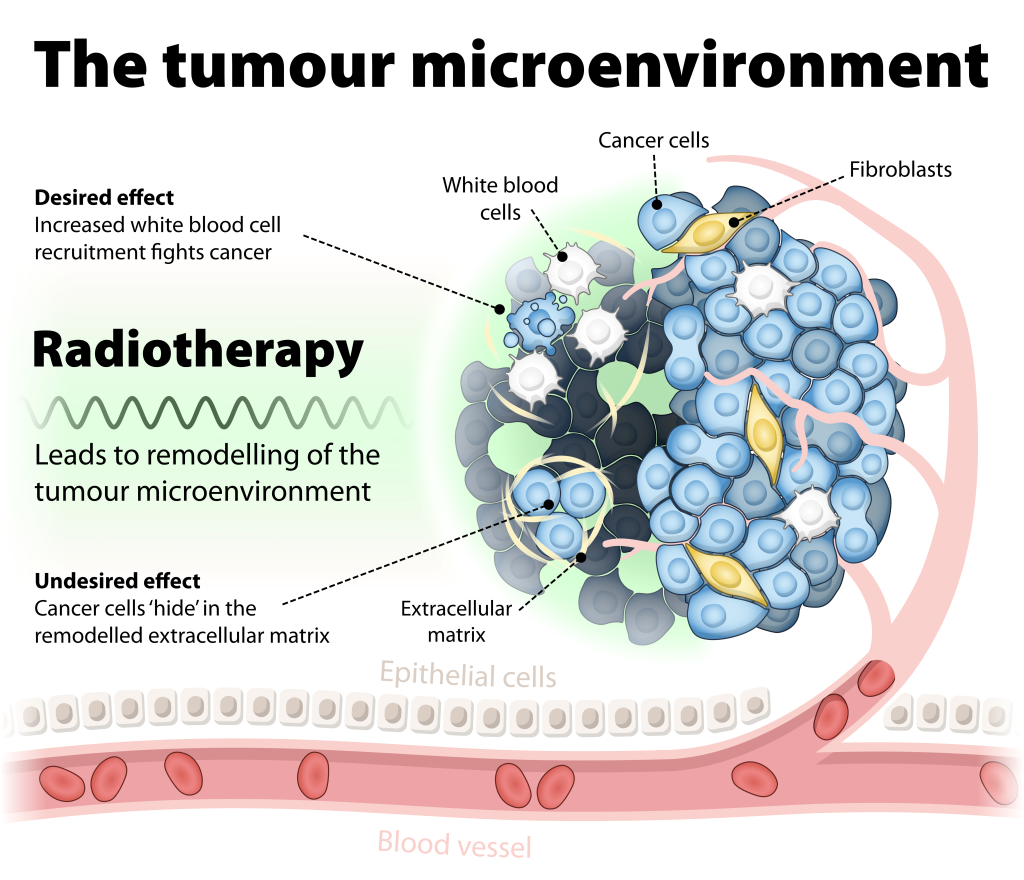Author: Yamini Meshram // Editor: Erin Pallott
Imagine you are giving your home a fresh coat of paint, but instead of just changing the colour, you end up remodelling the whole structure and even influencing the neighbourhood’s vibe. That’s a bit like what radiotherapy does in the world of breast cancer treatment. Sure, it’s known for zapping cancer cells, but its impact goes way beyond that. It’s like the treatment is remodelling the cancer’s “home” – the extracellular matrix (ECM) and the tumour environment. This isn’t just a facelift; it’s a deep transformation affecting how cancer interacts with its surroundings. Let’s dive into how this happens and why it’s a big deal for beating breast cancer.
The ECM and Tumour Environment Makeover
The ECM is like the scaffolding around cells, keeping everything in place. In breast cancer, radiotherapy shakes things up, changing both the ECM’s structure and makeup. This isn’t just a minor tweak; it’s a major overhaul affecting the whole neighbourhood – the tumour environment. This area includes the cancer cells, the immune cells standing guard, the extracellular matrix, structural cells, and all the cellular messenger molecules passing information around.
By using techniques like mass spectrometry, researchers are mapping out these changes. They are showing that radiotherapy is more than just a hammer to smash cancer cells; it’s a tool that reshapes the battleground. By studying the entire tumour environment and its cells following radiotherapy, we can understand more about how complex tissues interact with each other, and how immune responses towards cancer cells can be altered. Understanding the whole neighbourhood will be essential for advancing cancer treatment strategies.
The Ripple Effects in the Tumour Neighbourhood
When the ECM gets a makeover, it’s not just about looks; it changes the dynamics in the tumour’s neighbourhood. For instance, it can either attract immune cells to fight the cancer or, on the flip side, create a hideout for cancer to grow unchecked. The behaviour of stromal cells, which are like the local construction workers of the cancer world, also changes, affecting how cancer spreads and grows.
Understanding these dynamics is crucial. It’s like knowing who’s who in a neighbourhood; by figuring out how to influence the local dynamics, we can find new ways to stop cancer in its tracks.

Listening to the Cellular Chatter
Just as a neighbourhood evolves, so does the conversation among its residents. Cells are always communicating, secreting chemical messengers that nearby cells can receive. After radiotherapy, the chatter among cells and their environment shifts. Researchers can listen in using RNA sequencing, a way to eavesdrop on these cellular conversations. This tells us how cells adapt to their new environment and how the community of cells – including immune and stromal cells – responds to the changes brought by radiotherapy.
This intel is gold. It helps identify new targets for therapy, like finding the key influencers in a community who can sway the neighbourhood’s future. It can also tell us how effective the radiotherapy is. Is it curbing the cancer progression and promoting anti-tumour immune responses, or are there side effects curbing the treatment outcomes? This research will help optimise radiotherapy strategies to maximise the therapeutic benefits of killing cancer cells and arming the immune cells and minimising any negative responses.
A New Strategy for Breast Cancer Treatment
Armed with this knowledge, the approach to breast cancer therapy is evolving. It’s not just about killing cancer cells anymore. It’s about understanding and manipulating the whole environment where cancer lives. By figuring out how radiotherapy changes the ECM and the tumour environment, new treatments can be designed. These might not only aim at the cancer cells but also tweak the environment to help beat cancer, like making it easier for the immune system to attack or cutting off the pathways cancer uses to spread.
Paving the Way for Future Treatments
This research is more than just academic; it’s a game-changer for breast cancer treatment. It highlights the need to look beyond the cancer cells themselves and consider the whole ecosystem of the tumour. As this understanding deepens, it paves the way for more personalised and effective cancer care, turning the tide in the fight against breast cancer.
Understanding the impact of radiotherapy on the ECM and tumour environment in breast cancer is like unlocking a new level in a video game. It opens a realm of possibilities for new strategies and treatments, offering hope and new directions in the battle against this disease.
By taking this holistic view, the future of breast cancer treatment is looking brighter, offering new hope to patients worldwide. It’s a complex puzzle, but piece by piece, we’re getting closer to solving it, aiming for a future where breast cancer can be beaten not just by attacking it directly but also by keeping its environment healthy.
In Conclusion
Radiotherapy’s role in breast cancer treatment is undergoing a revolution. By understanding its profound effects on the ECM and tumour environment, we’re not just fighting cancer on one front but transforming the entire battlefield. This holistic approach opens new avenues for treatment, making the fight against breast cancer more strategic and, hopefully, more effective. It’s an exciting time in cancer research, as we explore these new frontiers and move closer to turning the tide against breast cancer for good.
Discover more from Research Hive
Subscribe to get the latest posts to your email.
